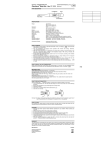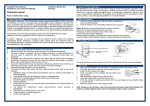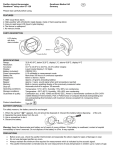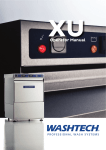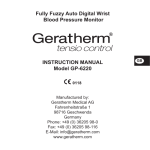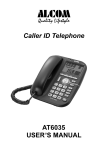Download user manual Geratherm desktop
Transcript
Digital Blood Pressure Monitor for the Upper Arm GB INSTRUCTION FOR USE Contents Designated Use ............................................. Precautions .................................................... Warranty ......................................................... Information You Should Know Before Operating the Unit ............................ 24 25 27 27 About the Unit Explanation of Display ................................. 28 Preparation for Use Installing/Replacing Batteries ...................... 29 Attaching the Pressure Cuff ......................... 30 Measuring Posture ....................................... 30 GB How to Operate the Unit Setting the Clock .......................................... Measuring Blood Pressure .......................... Recalling Memories ..................................... Erasing Memories ........................................ 31 31 32 33 Care and Maintenance ................................... Error Message ................................................ Disposal .......................................................... Specifications ................................................. Quality Standard ............................................ Symbol Index .................................................. Annex .............................................................. 34 36 36 37 38 38 39 Designated Use This unit uses an oscillometric measurement method in order to measure systolic and diastolic blood pressure, as well as the heart rate. The measurement is conducted on the upper arm. All values can be read on an LCD screen. This unit has been developed for home and professional use and should only be used by adults over 18 years of age with an arm diameter of 22 ~ 32 cm / 8.7 - 12.6 inches. 24 Precautions • This manual and the product are not substitutes for visiting the doctor. Neither the information contained herein nor this product may be used to diagnose or treat health problems, or to prescribe drugs. If you have or suspect that you have a medical problem, please seek immediate advice from your doctor. • Do not conduct any measurements if the temperature is low (below +5 °C) or high (over +40 °C), or if the relative humidity is beyond the range of 15 % to 90 %, as this can lead to inaccurate readings. • Wait 30 to 45 minutes, before taking a measurement if you have just had a caffeinated drink or a cigarette. • Relax for at least 5 to 10 minutes before taking a measurement. • Please wait 3 to 5 minutes between measurements, so that your blood vessels can return to the state they were in prior to measurement. You may have to adapt the waiting time to your personal physiology. • It is recommended that you use the same arm for each measurement (preferably the left) and take the measurement at about the same time every day. • Sit down comfortably with your elbows placed on the table and both feet on the ground. Please do not interlock your legs during the measurement. • Place the unit at the level of the heart. Relax your hand. Your palm should be facing up. • Take the measurement at room temperature in a quiet and stress-free environment. • The unit should not be moved or shaken during the measurement. Please do not speak during the measurement. • Please keep in mind that blood pressure naturally varies depending on the time of day and is affected by many different factors. Blood pressure is usually highest at work and reaches its lowest level during the sleep phase. • Blood pressure measurements should be assessed by a doctor or trained healthcare professional who is familiar with your medical history. If you use the unit and regularly record the results, please keep your doctor informed with regard to the ongoing changes in your blood pressure. • If you suffer from a cardiovascular disease (such as atherosclerosis), diabetes, a liver or kidney disease, 25 GB Precautions • • • • • • GB • • • • severe hypertension or peripheral circulatory disorders, etc., please consult your doctor before using this unit. The performance of this device can be influenced as severe arrhythmias such as atrial or ventricular premature beats or atrial fibrillation are presented during measurement. The blood pressure measurements conducted with this unit are equivalent to measurements obtained by a trained observer in accordance with the values achieved using the cuff/stethoscope auscultation method and are within the specified EN 1060-4 standard limits. If the cuff causes any discomfort during the measurement, press the “POWER” button to turn off the unit immediately. If the pressure is over 300 mmHg and the cuff does not deflate automatically, pull off the Velcro strap to detach the cuff. Do not use this appliance on infants, children or persons who cannot express their own intentions. To avoid accidental strangulation, keep the product away from children and do not place the hose around the neck. Measuring too frequently may result in circulatory disorders, which can cause unpleasant sensations such as localised bleeding under the skin or temporary numbness in your arm. These symptoms do not usually last long. However, if you have not recovered after some time, please consult your doctor. Please take into consideration the electromagnetic compatibility of the unit (e.g. disruptions to the power supply, radio frequency interference, etc.) see annex. Please only use the unit indoors. To avoid inaccurate results due to electromagnetic interference between electrical and electronic equipment, please do not use the unit near mobile phones or microwave ovens. In the case of devices whose maximum power exceeds 2 W, the minimum distance from your blood pressure monitor should be 3.3 metres. The unit is not waterproof. Never immerse this instrument in any liquids. Do not use the instrument if you think it is damaged or if you notice anything unusual. 26 Warranty The warranty for this blood pressure monitor is valid for any error on the part of the manufacturer under normal use for 3 years from the date of purchase. If your unit does not function properly due to defective parts or assembly, we will repair it free of charge. With the exception of the battery and cuff, all parts of the unit are subject to this warranty. Damage caused by improper handling of your unit is not guaranteed. We recommend that the accuracy of the unit be checked after 2 years from manufacturing date by an authorized laboratory. This checking procedure is not a service provided under the warranty. Information you should know before operating the unit What is blood pressure? A force is created by the heart as the ventricle forcibly ejects blood into the blood vessels and through the transport system. Another force is created by the arteries as they resist the blood flow. Blood pressure is the result of these two forces. What are systolic and diastolic pressures? Systolic pressure represents the highest pressure at the height of the heart‘s contraction. Diastolic pressure is the lowest pressure when the heart is resting. Is my blood pressure normal? See the following blood pressure classification chart released by the WHO (World Health Organization) for evaluation of your blood pressure level. Diastolic mm Hg Severe hypertension (Grade 3) Moderate Hypertension (Grade 2) High - normal Normal Optimal 27 Systolic mm Hg Mild Hypertension (Grade 1) GB Information you should know before operating the unit What about low blood pressure? In general, a lower blood pressure reading is better unless it causes some uncomfortable symptoms such as fainting and/or lightheadedness. Fluctuation and variation in blood pressure The following chart shows possible blood pressure fluctuations during a 24hr period. mmHg Systolic Diastolic The following factors will influence blood pressure measurement results and cause variations. GB • Bathing • Conversation • Exercise • Mental tension • Temperature change • Smoking etc. • Breathing • Drinking alcohol • Moving • Meals • Thoughts About the unit Explanation of Display Memory Systolic Arrhythmia Detection Date/ Time Pulse 28 Diastolic Low Battery About the Unit Cuff access for power supply On/Off Button LCD Display Memory Button The cuff is designed to fit arm sizes between 22 and 32cm (8.7 to 12.6 inches.) Preparation for Use Installing/Replacing Batteries 1. Insert the batteries into the battery compartment matching correct polarities „+“ and „-“. 2. Replace all batteries if the low battery indicator appears. 3. Remove the batteries if the unit will not be usedfor a long period of time. 4. REMOVE all of the BATTERIES when utilizing the optional AC adapter. Note: It is recommended that the same type of alkaline batteries be used to avoid incompatibility. Keep batteries away from small children. Do not throw batteries into fires: they could explode. 29 GB Preparation for Use Attaching the Pressure Cuff 1. Wrap the cuff around the left arm. The arm should be bare skin. 2. Fasten the cuff. Don‘t pull it strongly and make the cuff too tight. The cuff‘s edge should be approximately 1 inch from crook of the arm. 3. Attach the cuff on the right hand as shown in the figure if it is not possible to measure on the left arm. Measuring Posture 1. Sit upright and ensure that the measuring site is at heart level. Relax and measure in a natural position. GB 2. Measure and record blood pressure at the same time every day to establish your blood pressure pattern. AC Adapter (accessory) Use the device only with a medical approved stabilized AC adapter (Input: 100~240 V, AC, 60/50Hz; Output: 6V, DC, 800mA). Note: 1. No batteries are required during operation using the AC adapter. 2. If AC adapter power is interrupted during measurement, the device must be reset by disconnecting the AC adapter from the device. 3. Only use medical approved adapters that comply with the specifications in this manual. Using other adapters could cause damage your blood pressure monitor. 30 How to Operate the Unit 1.Setting the Clock To enter the setting mode by pressing and holding the memory key for over 3 seconds. The display will show a blinking year. Press the power key to adjust the year when it is blinking. Then press and release the memory key again, the “month” will appear and blink to be adjusted, and then “date”, “hour” and “minute” will follow up as you press and release the memory key again. To adjust the clock Press the memory key to adjust the values of the ”month”, “date”, “hour”, and “minute” when they are blinking. GB 2. Measuring Blood Pressure Press and release the POWER key to start measuring automatically Î Initial display Î Pumping Î Measuring and Buzzer sounds. When the measurement is finished, the display will show the measured blood pressure and pulse value. Press the power key to turn off the unit. Otherwise the unit will turn off automatically 150 seconds later. 31 How to Operate the Unit Note: If the symbol appears, it means the unit has detected irregular pulse during measurement. If the symbol appears regularly please consult a qualified physician for professional advice. 3. Recalling Memories Press and release the MEMORY key to recall the last reading (Example: the no.7 memory). The display will show the memorized pressure and pulse value. GB Press and release the MEMORY key again to recall the no.6 memory. Press and release repeatedly to read the no 5, 4, 3, 2, 1 memorized pressures. 32 How to Operate the Unit 4. Erasing Memories You may erase one or all records in memory. Delete one record 1. Press and release MEMORY key to choose the record that you wish to delete 2. Press and hold the POWER key until the display shows “dEL”. 3. Press and release the power key again. After 3 beeps are heard, the unit erases the record. Delete all records 1. Press and release MEMORY key to choose the record that you wish to delete. 2. Press and hold the POWER key until the display shows “dEL”. 3. Press and release the MEMORY key then the display shows “dEL ALL”. 4. Press and release the POWER key. After 3 beeps are heard, the unit erases all records. 33 GB Care and Maintenance Do not drop the unit. It is not shock-proof. Do not modify or disassemble the unit or the arm cuff. GB Do not twist the arm cuff. Use a cloth moistened with water or neutral detergent to clean the body of the unit and then wipe it dry. 34 Care and Maintenance Avoid thinner, benzine, and other harsh cleaners. Keep the unit in a suitable place. Avoid high temperature, direct sunlight, high moisture, and dust. GB Remove the batteries if the unit will not be used for a long time. Do not press the POWER button if the cuff has not been properly wrapped around the arm. 35 Error Messages The pressure measured was lower than 20 mm Hg. Please measure again. Excessive body movement is detected during measurement. Please measure again. Pumping error. Please check cuff and try again. The pressure can not be measured due to signal noise. Please measure again. The pumping pressure is higher than 300 mm Hg. Please measure again. Low battery. Check and replace the 4 batteries if necessary. GB Disposal Observe the applicable regulations when disposing of the device and batteries. This product must not be disposed of together with domestic waste. All users are obliged to hand in all electrical or electronic devices, regardless of whether or not they contain toxic substances, at a municipal or commercial collection point so that they can be disposed of in an environmentally acceptable manner. Please remove the batteries before disposing of the device/unit. Do not dispose of old batteries with your household waste, but at a battery collection station at a recycling site or in a shop. 36 Specifications Model no. GP-6621 Display System Liquid Crystal Display Measuring Method Oscillometric Power Source 4 alkaline “AA“ type batteries (1.5 V) or AC adapter (input: 100~240 V, AC, 60/50 Hz; output: 6 V, DC, 800 mA) Measuring Range Blood pressure: 20 to 300 mmHg Heart pulse rate: 40 to 200 pulse beats/min Accuracy Blood pressure: Heart pulse rate: ±3 mm Hg pulse rate: ±5 % Inflation Pressure Exhaust Electric solenoid valve Micro rolling pump Memory 85 sets Display LCD (year/date/time, pressure and pulse) Low Battery Indicator Yes Auto Power-Off 150 secs. without any operation Battery Life Around 250 measurements Protection Level IP20 (protected against foreign bodies < 12,5 mm) Cuff Size 22 to 32 cm / 8.7 - 12.6 inches Operating Environment +5 °C to +40 °C; RH 15 % to 90 % (+41 °F to +104 °F) Storage Environment -25 °C to +55 °C; RH 15 % to 90 % (-4 °F to +122 °F) Dimensions 171 mm x 139 mm x 54 mm Weight around 550 g (including batteries) Specifications are subject to change for improvement without notice. 37 GB Quality Standard Geratherm® is certified in accordance with Council Directive 93/42/EEC and EN ISO 13485 and is entitled to affix the CE-mark 0197 (Notified Body: TÜV Rheinland LGA Products GmbH). The blood pressure monitor conforms to • EN 1060-1 (Non-invasive sphygmomanometers part 1: General requirements) • EN 1060-3 (Non-invasive sphygmomanometers part 3: Supplementary requirements for electromechanical blood pressure measuring systems) • EN 1060-4 Non-invasive sphygmomanometers, Part 4: Test procedures to determine the overall system accuracy of automated non-invasive sphygmomanometers GB Symbol index Follow the instructions for use Type BF Equipment Keep dry Batch code (mm/yyyy; month/year) 90% Store between 15 % and 90 % R.H. SN Serial number 15% +55°C Store between -25 °C and +55 °C Manufacturer The device must not be disposed of with household waste. Important! Read the instruction manual! -25°C 38 Annex Information on electromagnetic compatibility (EMC) Electronic devices such as PCs and mobile phones can lead to the exposure of medical devices in operation to electromagnetic interference from other devices. This can lead to malfunction of the medical device and create a potentially unsafe situation. Medical devices should also not interfere with any other devices. The EN 60601-1-2 standard regulates the requirements for EMC (electromagnetic compatibility) and defines the levels of immunity to electromagnetic interference and the maximum electromagnetic emission levels for medical devices. This blood pressure monitor, which is manufactured by Geratherm Medical AG, complies with the EN 60601-1-2 standard in relation to both immunity and emissions. However, special precautions should be observed: please only use the device indoors and not in the vicinity of mobile phones or microwave ovens. In the case of devices whose maximum power exceeds 2 W, the minimum distance from your blood pressure monitor should be 3.3 metres. 39 GB Annex Guidance and manufacturer´s declaration – electromagnetic emissions The device is intended for use in the electromagnetic environments listed below, and should only beused in such environments: Emissions test Compliance Electromagnetic environment - guidance RF emissions CISPR 11 Group 1 RF energy is used only to maintain device’s operation. Therefore, its RF emissions are so low that it’s not likely to cause any interference in nearby electronic equipment. RF emissions CISPR 11 Class B Harmonic emissions IEC 61000-3-2 Class A Voltage fluctuations / flicker emissions IEC 61000-3-3 complies The device is suitable for use in all establishments, including domesticestablishments, and those directly connected to the public low-voltage power supply networkthat supplies buildings used for domestic purposes. Guidance and manufacturer´s declaration – electromagnetic emissions The device is intended for use in the electromagnetic environments listed below, and should only beused in such environments: Immunity test IEC 60601 – test level Compliance level Electromagnetic environment guidance Electrostatic discharge (ESD) IEC 61000-4-2 ± 6 kV contact ± 8 kV air ± 6 kV contact ± 8 kV air Floors should be wood, concrete or ceramic tile. If floors are covered with synthetic material, the relative humidity should be at least 30 %. Power frequency (50/60 Hz) magnetic field IEC 61000-4-8 3 A/m 3 A/m Power frequency magnetic fields should be at levels characteristic of a typical location in a typicalcommercial or hospital environment. GB Recommended separation distances between portable and mobile RF communication The device is intended for use in an electromagnetic environment where radiated RF disturbancesare under control. User can help prevent electromagnetic interference by keeping the device at a minimum distance from portable and mobile RF communications equipment (transmitters). Below table details the maximum output power of transmitter: Rated maximum output power of transmitters in Watt Seperation distance according to frequency of transmitter / m 150 kHz to 80 MHz d = 1.2 √P 80 MHz to 800 MHz d = 1.2 √P 800 MHz to 2.5 GHz d = 2.3 √P 0.01 0.1 1 10 100 0.12 0.38 1.2 3.8 12 0.12 0.38 1.2 3.8 12 0.23 0.73 2.3 7.3 23 For transmitters rated at a maximum output power not listed above, the recommended separation distance d in metres (m) can be estimated using the equation applicable to the frequency of the transmitter, where P is the maximum output power rating of the transmitter in watts (W) according to the transmitter manufacturer. NOTE 1: NOTE 2: At 80 MHz and 800 MHz, the separation distance for the higher frequency range applies. These guidelines may not apply in all situations. Electromagnetic propagation is affected by absorption and reflection from structures, objects and people. 40 Annex Guidance and manufacturer´s declaration – electromagnetic immunity The device is intended for use in the electromagnetic environments listed below, and should only be used in such environments: IEC 60601 Compliance Immunity test – test Electromagnetic environment - guidance level level Portable and mobile RF communications equipment should be used no closer to any part of the device, including cables, than the recommended separation distance calculated from the equation applicable to the frequency of the transmitter. Recommended separation distance: Conducted RF IEC 61000-4-6 Radiated RF IEC 61000-4-3 3 Vrms 150 kHz to 80 MHz 3 V/m 80 MHz to 2.5 GHz 3 Vrms d = 1.2 √P 3 V/m d = 1.2 √P 80 MHz to 800 MHz d = 2.3 √P 800 MHz to 2.5 GHz where P is the maximum output power rating of the transmitter in watts (W) according to the transmitter manufacturer and d is the recommended separation distance in metres (m). Field strengths from fixed RF transmitters, as determined by an electromagnetic site survey,a should be less than the compliance level in each frequency range.b NOTE 1: NOTE 2: Interference may occur in the vicinity ofequipment marked with the following symbol: At 80 MHz and 800 MHz, the higher frequency range applies. These guidelines may not apply in all situations. Electromagnetic propagation is affected by absorption and reflection from structures, objects and people. Guidance and manufacturer´s declaration – electromagnetic immunity a) Field strengths from fixed transmitters, such as base stations for radio (cellular/cordless) telephones and land mobile radios, amateur radio, AM and FM radio broadcast and TV broadcast cannot be predicted theoretically with accuracy. To assess the electromagnetic environment due to fixed RF transmitters, an electromagnetic site survey should be considered. If the measured field strength in the location in which the device is used exceeds the applicable RF compliance level above, the device should be observed to verify normal operation. If abnormal performance is observed, additional measures may be necessary, such as reorienting or relocating the device. b) Over the frequency range 150 kHz to 80 MHz, field strengths should be less than 3 V/m. Geratherm Medical AG Fahrenheitstrasse 1 98716 Geschwenda Germany www.geratherm.com 41 GB























